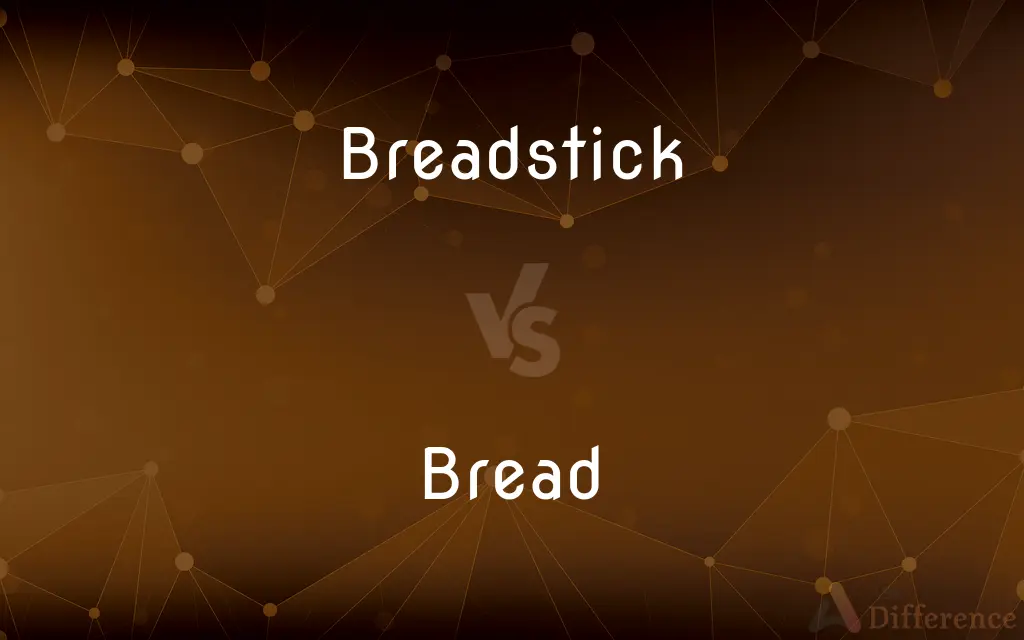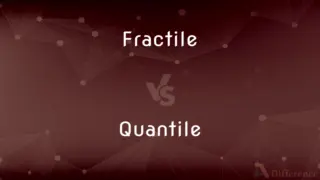Breadstick vs. Bread — What's the Difference?
By Maham Liaqat & Fiza Rafique — Updated on April 27, 2024
Breadsticks are thin, crunchy elongated pieces of baked bread dough, often seasoned, while bread comes in various shapes, sizes, and textures, typically soft and used as a staple food.

Difference Between Breadstick and Bread
Table of Contents
ADVERTISEMENT
Key Differences
Breadsticks, originally from Italy, are typically long, thin, and crispy, ideal as an appetizer or snack. Bread, on the other hand, is a more substantial staple food that comes in numerous forms such as loaves, rolls, and buns, serving as a main component of meals worldwide.
Breadsticks are often seasoned with ingredients like garlic, herbs, or cheese to enhance flavor, making them suitable for pairing with dips. Bread, whereas, is generally not heavily seasoned to maintain versatility in pairing with a variety of foods from different cuisines.
While breadsticks are usually made from a simple dough of flour, water, yeast, and salt, and then baked until crisp, bread involves a wider variety of recipes and techniques, including the use of fats, sugars, and sometimes eggs, leading to a softer texture.
The production of breadsticks typically involves rolling the dough into thin, stick-like shapes before baking. On the other hand, bread dough can be shaped into numerous forms and sizes, and its preparation might include steps like kneading and proofing to develop texture and flavor.
Breadsticks are commonly served as a side or an appetizer in restaurants, particularly in Italian dining settings. Bread, however, is universally consumed in various settings as a primary food item, often used to make sandwiches or as a side to main dishes.
ADVERTISEMENT
Comparison Chart
Origin
Italian cuisine
Global
Texture
Crispy and dry
Soft to crusty, varies widely
Use
Often served as appetizer or with dips
Staple food, versatile in use
Seasoning
Commonly seasoned with garlic, herbs, or cheese
Generally unseasoned, sometimes topped
Preparation
Rolled into thin shapes and baked until crisp
Various shapes, often involves proofing
Compare with Definitions
Breadstick
Generally enjoyed crisp.
Crisp breadsticks complement a soft cheese spread perfectly.
Bread
Can be found in various forms such as loaves and rolls.
She packed sandwiches made from freshly baked bread rolls.
Breadstick
Often seasoned with garlic or herbs.
The restaurant serves rosemary breadsticks with every meal.
Bread
Serves as a primary or side dish.
We had soup and bread for lunch.
Breadstick
Originates from Italian cuisine.
Authentic Italian breadsticks are a must-try.
Bread
A staple food made from flour, water, and yeast.
I bake fresh bread every Sunday.
Breadstick
A thin, crispy piece of baked bread dough.
For dinner, we had salad and garlic breadsticks.
Bread
The texture varies from soft to crusty.
He prefers crusty bread with his stew.
Breadstick
Commonly served as an appetizer or snack.
Breadsticks are my go-to snack with marinara dip.
Bread
Used universally across different cultures.
Bread is considered an essential food in many diets around the world.
Breadstick
Breadsticks, also known as grissini, grissino or dipping sticks, are generally pencil-sized sticks of crisp, dry baked bread that originated in Italy.
Bread
Bread is a staple food prepared from a dough of flour and water, usually by baking. Throughout recorded history, it has been a prominent food in large parts of the world.
Breadstick
A long, thin, crisp piece of baked dough.
Bread
A staple food made from flour or meal mixed with other dry and liquid ingredients, usually combined with a leavening agent, and kneaded, shaped into loaves, and baked.
Breadstick
A long, very slender loaf of crisp bread smaller than a baguette; for example, grissini from Italy and rosquilletas from Spain.
Bread
Food in general, regarded as necessary for sustaining life
"If bread is the first necessity of life, recreation is a close second" (Edward Bellamy).
Breadstick
A crisp stick-shaped roll; often served with soup
Bread
Something that nourishes; sustenance
"My bread shall be the anguish of my mind" (Edmund Spenser).
Bread
Means of support; livelihood
Earn one's bread.
Bread
(Slang) Money.
Bread
To coat with bread crumbs, as before cooking
Breaded the fish fillets.
Bread
(uncountable)
Bread
A foodstuff made by baking dough made from cereals.
We made sandwiches with the bread we bought from the bakery.
Any leftover bread can be put into the pudding.
Bread
Food; sustenance; support of life, in general.
Bread
(countable) Any variety of bread.
Bread
Money.
Bread
Breadth.
Bread
A piece of embroidery; a braid.
Bread
(transitive) To coat with breadcrumbs.
Breaded fish
Bread
To make broad; spread.
Bread
(transitive) To form in meshes; net.
Bread
To spread.
Bread
To cover with bread crumbs, preparatory to cooking; as, breaded cutlets.
Bread
An article of food made from flour or meal by moistening, kneading, and baking.
Bread
Food; sustenance; support of life, in general.
Give us this day our daily bread.
Bread
Food made from dough of flour or meal and usually raised with yeast or baking powder and then baked
Bread
Informal terms for money
Bread
Cover with bread crumbs;
Bread the pork chops before frying them
Common Curiosities
What is bread?
Bread is a staple food prepared from a dough of flour and water, usually by baking. It comes in various shapes and sizes and is a fundamental part of many diets globally.
Can breadsticks be soft?
Yes, there are varieties of breadsticks that are soft and chewy, similar to the texture of soft breads.
How are breadsticks different from regular bread?
Breadsticks are typically more crispy and slender, whereas bread is softer with a more substantial volume.
Do breadsticks have any cultural significance?
In Italian cuisine, breadsticks have a historical presence and are traditional accompaniments in meals, symbolizing Italian culinary traditions.
What types of flour are used to make breadsticks and bread?
Both can be made from various types of flour, including wheat, rye, and gluten-free options, but the specific recipe and preparation method can affect the texture.
What is the cultural significance of bread in cuisine?
Bread is significant in many cultures worldwide, often seen as a symbol of shared living and essential sustenance, featured prominently in many religious and cultural ceremonies.
How does the preparation of breadsticks differ from bread?
Breadstick dough is often rolled into thin shapes and may be baked until crisp, while bread dough is typically bulkier and baked until it's soft and risen.
What are some common flavors for breadsticks?
Garlic, sesame, parmesan, and herbs are popular flavorings added to breadsticks.
Are breadsticks gluten-free?
Traditional breadsticks contain gluten, but gluten-free versions are available made from alternative flours like rice or almond flour.
How are breadsticks served?
Breadsticks are often served as an accompaniment to dishes like salads, soups, or pasta, or used as a snack, sometimes with dips.
What are breadsticks?
Breadsticks, also known as grissini, are long, thin pieces of crisp bread often served as an appetizer or snack, especially in Italian cuisine.
Are breadsticks healthier than bread?
The healthiness depends on the ingredients used. Breadsticks often contain more oil and sometimes sugar, making them higher in calories compared to some breads.
What is the best way to store breadsticks and bread?
Breadsticks should be kept in an airtight container to maintain crispness, while bread is best stored in a bread box or wrapped to retain moisture and softness.
Why might someone choose breadsticks over bread?
Breadsticks can be chosen for their crisp texture and ease of serving with dips or as a part of a platter, offering a different texture and flavor profile compared to regular bread.
Can you make breadsticks at home?
Yes, breadsticks can be easily made at home with basic ingredients like flour, yeast, water, and oil.
Share Your Discovery

Previous Comparison
Fractile vs. Quantile
Next Comparison
Junky vs. JunkieAuthor Spotlight
Written by
Maham LiaqatCo-written by
Fiza RafiqueFiza Rafique is a skilled content writer at AskDifference.com, where she meticulously refines and enhances written pieces. Drawing from her vast editorial expertise, Fiza ensures clarity, accuracy, and precision in every article. Passionate about language, she continually seeks to elevate the quality of content for readers worldwide.
















































